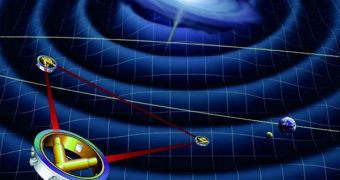The US National Aeronautics and Space Administration announced in a recent statement that it will drop out of a joint project it had set up with the European Space Agency (ESA). The goal of the mission was to discover and analyze gravitational waves.
These are ripples in spacetime that have been proposed under Albert Einstein's theory of general relativity. Discovering them has never been possible before, seeing how we never had the technological means to do so until now.
This is why the Laser Interferometer Space Antenna (LISA) satellite constellation was proposed only now. Initially, NASA and ESA agreed to work together on developing the spacecraft, and set a 2015 launch date, but all hopes of a collaboration were shattered recently.
With the vote on the new NASA budget finally in, it became painfully obvious for experts at the American space agency that they will be unable to get the money needed to continue their participation.
As such, the two organizations announced the conclusion of their cooperation in this regard. ESA will go on on its own, and will most likely ask experts to develop a smaller-scale version of the same mission, Space reports.
“ESA has ended the partnership with NASA because NASA is financially unable to participate when ESA's funding is available (in 2015),” explains NASA LISA project scientist Robin Stebbins.
“To preserve their program, ESA's must solicit a downscaled mission concept that does not rely on the availability of NASA funding, which they are doing,” he goes on to say in an email.
“ESA has invited NASA to nominate one member to the science team for the ESA-led gravity wave observatory now being formulated. We will remain engaged in the process and look forward to an opportunity to participate in the ESA effort,” NASA spokesman Trent Perrotto explains.
However, it's pretty clear that NASA will mainly act as an observer in this tremendously complex mission. Its collaboration with ESA will be minimal, and this state of affairs hurt both agencies.
“The amount of science likely to be accomplished by either agency alone will certainly be less than LISA. After 25 years at hard labor, I'm still convinced that a gravitational wave mission will happen. There are hundreds of other researchers with similar strong convictions,” Stebbins goes on to say.
In addition to the funding cuts, NASA was also plagued by cost overruns from missions such as the James Webb Space Telescope (JWST), and by the fact that the 2011 National Research Council Decadal Survey prioritizes other missions than LISA.
One good example is the Wide-Field Infrared Survey Telescope (WFIRST), an instrument developed to find dark energy and study exoplanets. “It has been understood for a long time that only one of several major mission concepts could move forward in the coming decade,” Perrotto concludes.

 14 DAY TRIAL //
14 DAY TRIAL //